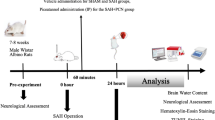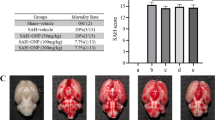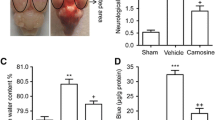Abstract
Paeoniflorin is a natural monoterpene glucoside from Paeoniae Radix with neuroprotective properties. However, it is still unclear whether paeoniflorin has neuroprotective effects on subarachnoid hemorrhage (SAH). This study explores the effect of paeoniflorin on early brain injury (EBI) using rat SAH model. We found that paeoniflorin significantly improves neurological deficits, attenuates brain water content and Evans blue extravasation at 72 h after SAH. Paeoniflorin attenuates the oxidative stress following SAH as evidenced by decrease of reactive oxygen species (ROS), malondialdehyde (MDA), 3-Nitrotyrosine, and 8-Hydroxy-2-deoxy guanosine (8-OHDG) level, increase of superoxide dismutase (SOD), glutathione peroxidase (GSH-Px), and catalase activity, and up-regulates the nuclear factor erythroid‑related factor 2 (Nrf2)/heme oxygenase‑1 (HO-1) pathway. Inhibition of microglia activation and neuro-inflammatory response both contributed to paeoniflorin’s protective effects. Moreover, paeoniflorin treatment significantly reduces the ratio of Bax/Bcl-2, active caspase-3/ neuronal nuclei (NeuN) and TUNEL/DAPI positive cells at 72 h following SAH. Our results indicate that paeoniflorin may attenuate early brain injury after experimental SAH.






Similar content being viewed by others
References
Ayer RE, Zhang JH (2008) Oxidative stress in subarachnoid haemorrhage: significance in acute brain injury and vasospasm. Acta Neurochir Suppl 104:33–41
Cao BY et al (2010) Paeoniflorin, a potent natural compound, protects PC12 cells from MPP + and acidic damage via autophagic pathway. J Ethnopharmacol 131:122–129. doi:https://doi.org/10.1016/j.jep.2010.06.009
Cao S et al (2016) Hydrogen sulfide attenuates brain edema in early brain injury after subarachnoid hemorrhage in rats: Possible involvement of MMP-9 induced blood-brain barrier disruption and AQP4 expression. Neurosci Lett 621:88–97. doi:https://doi.org/10.1016/j.neulet.2016.04.018
Cao C, He X, Wang W, Zhang L, Lin H, Du L (2006) Kinetic distribution of paeoniflorin in cortex of normal and cerebral ischemia-reperfusion rats after intravenous administration of Paeoniae Radix extract Biomedical chromatography. BMC 20:1283–1288. doi:https://doi.org/10.1002/bmc.658
Chen S et al (2014) Controversies and evolving new mechanisms in subarachnoid hemorrhage. Prog Neurobiol 115:64–91. https://doi.org/10.1016/j.pneurobio.2013.09.002
Chen G, Feng D, Zhang L, Dang B, Liu H, Wang Z (2013) Expression of Nemo-like kinase (NLK) in the brain in a rat experimental subarachnoid hemorrhage model. Cell Biochem Biophys 66:671–680. https://doi.org/10.1007/s12013-012-9511-6
Chen YF, Wu KJ, Wood WG (2013b) Paeonia lactiflora Extract Attenuating Cerebral Ischemia and Arterial Intimal Hyperplasia Is Mediated by Paeoniflorin via Modulation of VSMC Migration and Ras/MEK/ERK Signaling Pathway Evidence-based complementary and alternative medicine: eCAM 2013:482428 doi:https://doi.org/10.1155/2013/482428
Claassen J, Carhuapoma JR, Kreiter KT, Du EY, Connolly ES, Mayer SA (2002) Global cerebral edema after subarachnoid hemorrhage: frequency, predictors, and impact on outcome. Stroke 33:1225–1232
Fan LF et al (2017) Mdivi-1 ameliorates early brain injury after subarachnoid hemorrhage via the suppression of inflammation-related blood-brain barrier disruption and endoplasmic reticulum stress-based apoptosis. Free Radic Biol Med 112:336–349. doi:https://doi.org/10.1016/j.freeradbiomed.2017.08.003
Guo RB, Wang GF, Zhao AP, Gu J, Sun XL, Hu G (2012) Paeoniflorin protects against ischemia-induced brain damages in rats via inhibiting MAPKs/NF-kappaB-mediated inflammatory responses. PloS One 7:e49701. https://doi.org/10.1371/journal.pone.0049701
Hanafy KA (2013) The role of microglia and the TLR4 pathway in neuronal apoptosis and vasospasm after subarachnoid hemorrhage. J Neuroinflamm 10:83. doi:https://doi.org/10.1186/1742-2094-10-83
Hasegawa Y, Suzuki H, Sozen T, Altay O, Zhang JH (2011) Apoptotic mechanisms for neuronal cells in early brain injury after subarachnoid hemorrhage. Acta Neurochir Suppl 110:43–48. https://doi.org/10.1007/978-3-7091-0353-1_8
Huang CY et al (2015) Memantine alleviates brain injury and neurobehavioral deficits after experimental subarachnoid hemorrhage. Mol Neurobiol 51:1038–1052. doi:https://doi.org/10.1007/s12035-014-8767-9
Kooijman E, Nijboer CH, van Velthoven CT, Kavelaars A, Kesecioglu J, Heijnen CJ (2014) The rodent endovascular puncture model of subarachnoid hemorrhage: mechanisms of brain damage and therapeutic strategies. J Neuroinflamm 11:2. doi:https://doi.org/10.1186/1742-2094-11-2
Li Y et al (2016) Pharmacokinetic Comparison of Scutellarin and Paeoniflorin in Sham-Operated and Middle Cerebral Artery Occlusion Ischemia and Reperfusion Injury Rats after Intravenous Administration of Xin-Shao Formula Molecules 21 doi:https://doi.org/10.3390/molecules21091191
Li M, Wang Y, Wang W, Zou C, Wang X, Chen Q (2017) Recombinant human brain-derived neurotrophic factor prevents neuronal apoptosis in a novel in vitro model of subarachnoid hemorrhage. Neuropsychiatr Dis Treat 13:1013–1021. https://doi.org/10.2147/NDT.S128442
Liu DZ, Xie KQ, Ji XQ, Ye Y, Jiang CL, Zhu XZ (2005) Neuroprotective effect of paeoniflorin on cerebral ischemic rat by activating adenosine A1 receptor in a manner different from its classical agonists. Br J Pharmacol 146:604–611. doi:https://doi.org/10.1038/sj.bjp.0706335
Macdonald RL, Schweizer TA (2017) Spontaneous subarachnoid haemorrhage. Lancet 389:655–666. https://doi.org/10.1016/S0140-6736(16)30668-7
Manaenko A, Chen H, Kammer J, Zhang JH, Tang J (2011) Comparison Evans Blue injection routes: Intravenous versus intraperitoneal, for measurement of blood-brain barrier in a mice hemorrhage model. J Neurosci Methods 195:206–210. doi:https://doi.org/10.1016/j.jneumeth.2010.12.013
Mao QQ, Zhong XM, Feng CR, Pan AJ, Li ZY, Huang Z (2010) Protective effects of paeoniflorin against glutamate-induced neurotoxicity in PC12 cells via antioxidant mechanisms and Ca(2+) antagonism. Cell Mol Neurobiol 30:1059–1066. https://doi.org/10.1007/s10571-010-9537-5
Miller BA, Turan N, Chau M, Pradilla G (2014) Inflammation, vasospasm, and brain injury after subarachnoid hemorrhage . Biomed Res Int 2014:384342. https://doi.org/10.1155/2014/384342
Nam KN, Yae CG, Hong JW, Cho DH, Lee JH, Lee EH (2013) Paeoniflorin, a monoterpene glycoside, attenuates lipopolysaccharide-induced neuronal injury and brain microglial inflammatory response. Biotechnol Lett 35:1183–1189. doi:https://doi.org/10.1007/s10529-013-1192-8
Papadopoulos MC, Verkman AS (2013) Aquaporin water channels in the nervous system. Nat Rev Neurosci 14:265–277. https://doi.org/10.1038/nrn3468
Qi W et al (2018) Atorvastatin ameliorates early brain injury through inhibition of apoptosis and ER stress in a rat model of subarachnoid hemorrhage Biosci Rep 38 doi:https://doi.org/10.1042/BSR20171035
Schneider UC et al (2015) Microglia inflict delayed brain injury after subarachnoid hemorrhage. Acta Neuropathol 130:215–231. doi:https://doi.org/10.1007/s00401-015-1440-1
Sehba FA, Hou J, Pluta RM, Zhang JH (2012) The importance of early brain injury after subarachnoid hemorrhage. Prog Neurobiol 97:14–37. https://doi.org/10.1016/j.pneurobio.2012.02.003
Sugawara T, Ayer R, Jadhav V, Zhang JH (2008) A new grading system evaluating bleeding scale in filament perforation subarachnoid hemorrhage rat model. J Neurosci Methods 167:327–334. https://doi.org/10.1016/j.jneumeth.2007.08.004
Sun R, Wang K, Wu D, Li X, Ou Y (2012) Protective effect of paeoniflorin against glutamate-induced neurotoxicity in PC12 cells via Bcl-2/Bax signal pathway. Folia Neuropathol 50:270–276
Suzuki H (2019) Inflammation: a Good Research Target to Improve Outcomes of Poor-Grade Subarachnoid Hemorrhage. Transl Stroke Res . https://doi.org/10.1007/s12975-019-00713-y
Tang NY, Liu CH, Hsieh CT, Hsieh CL (2010) The anti-inflammatory effect of paeoniflorin on cerebral infarction induced by ischemia-reperfusion injury in Sprague-Dawley rats. Am J Chin Med 38:51–64. doi:https://doi.org/10.1142/S0192415X10007786
Tao YE, Wen Z, Song Y, Wang H (2016) Paeoniflorin attenuates hepatic ischemia/reperfusion injury via anti-oxidative, anti-inflammatory and anti-apoptotic pathways. Exp Ther Med 11:263–268. https://doi.org/10.3892/etm.2015.2902
van Gijn J, Kerr RS, Rinkel GJ (2007) Subarachnoid haemorrhage . Lancet 369:306–318. https://doi.org/10.1016/S0140-6736(07)60153-6
Wang K et al (2014) Protective effect of paeoniflorin on Abeta25-35-induced SH-SY5Y cell injury by preventing mitochondrial dysfunction. Cell Mol Neurobiol 34:227–234. https://doi.org/10.1007/s10571-013-0006-9
Wang W et al (2019) TAT-mGluR1 Attenuation of Neuronal Apoptosis through Prevention of MGluR1alpha Truncation after Experimental Subarachnoid Hemorrhage. ACS Chem Neurosci 10:746–756. doi:https://doi.org/10.1021/acschemneuro.8b00531
Wang Z, Guo S, Wang J, Shen Y, Zhang J, Wu Q (2017) Nrf2/HO-1 mediates the neuroprotective effect of mangiferin on early brain injury after subarachnoid hemorrhage by attenuating mitochondria-related apoptosis and neuroinflammation. Sci Rep 7:11883. https://doi.org/10.1038/s41598-017-12160-6
Wang T, Zhang XN, Wang L, Liang YC, Zhang L, Zhao DP, Liu YL (2018) Neuroprotective effect of riluzole in rat model of subarachnoid hemorrhage. Int J Clin Exp Med 11:9230–9238
Wu YM et al (2013) Phosphatidylinositol 3 kinase/protein kinase B is responsible for the protection of paeoniflorin upon H(2)O(2)-induced neural progenitor cell injury . Neuroscience 240:54–62. https://doi.org/10.1016/j.neuroscience.2013.02.037
Wu LY et al (2017) Roles of Pannexin-1 Channels in Inflammatory Response through the TLRs/NF-Kappa B Signaling Pathway Following Experimental Subarachnoid Hemorrhage in Rats. Front Mol Neurosci 10:175. https://doi.org/10.3389/fnmol.2017.00175
Wu Q et al (2017) Roflumilast Reduces Cerebral Inflammation in a Rat Model of Experimental Subarachnoid Hemorrhage. Inflammation 40:1245–1253. https://doi.org/10.1007/s10753-017-0567-8
Xiao L, Wang YZ, Liu J, Luo XT, Ye Y, Zhu XZ (2005) Effects of paeoniflorin on the cerebral infarction, behavioral and cognitive impairments at the chronic stage of transient middle cerebral artery occlusion in rats. Life Sci 78:413–420. https://doi.org/10.1016/j.lfs.2005.04.069
Xie Z et al (2018) Exendin-4 attenuates neuronal death via GLP-1R/PI3K/Akt pathway in early brain injury after subarachnoid hemorrhage in rats . Neuropharmacology 128:142–151. https://doi.org/10.1016/j.neuropharm.2017.09.040
Yan D, Saito K, Ohmi Y, Fujie N, Ohtsuka K (2004) Paeoniflorin, a novel heat shock protein-inducing compound. Cell Stress Chaperones 9:378–389
Yang Y, Chen S, Zhang JM (2017) The Updated Role of Oxidative Stress in Subarachnoid Hemorrhage. Curr Drug Deliv 14:832–842. doi:https://doi.org/10.2174/1567201813666161025115531
Zhang Y et al (2015) Paeoniflorin, a Monoterpene Glycoside, Protects the Brain from Cerebral Ischemic Injury via Inhibition of Apoptosis. Am J Chin Med 43:543–557. https://doi.org/10.1142/S0192415X15500342
Zhang ZY, Yang MF, Wang T, Li DW, Liu YL, Zhang JH, Sun BL (2015) Cysteamine alleviates early brain injury via reducing oxidative stress and apoptosis in a rat experimental subarachnoid hemorrhage model. Cell Mol Neurobiol 35:543–553. https://doi.org/10.1007/s10571-014-0150-x
Zhang Y et al (2017a) Paeoniflorin Attenuates Cerebral Ischemia-Induced Injury by Regulating Ca(2+)/CaMKII/CREB Signaling Pathway Molecules 22 doi:https://doi.org/10.3390/molecules22030359
Zhang ZY et al (2017) Enhanced Therapeutic Potential of Nano-Curcumin Against Subarachnoid Hemorrhage-Induced Blood-Brain Barrier Disruption Through Inhibition of Inflammatory Response and Oxidative Stress. Mol Neurobiol 54:1–14. https://doi.org/10.1007/s12035-015-9635-y
Zhang Z et al (2018) The GluN1/GluN2B NMDA receptor and metabotropic glutamate receptor 1 negative allosteric modulator has enhanced neuroprotection in a rat subarachnoid hemorrhage model. Exp Neurol 301:13–25. doi:https://doi.org/10.1016/j.expneurol.2017.12.005
Acknowledgements
This study was found by the Science and Technology Development Program of Tai’an city of Shandong province of China (2016NS1124).
Author information
Authors and Affiliations
Contributions
YL and TW designed experiment and analyzed the data. TW, LX, LG, LZ, XL, and YC performed the experiment. YL and TW wrote the manuscript. All authors read and approved this manuscript.
Corresponding authors
Ethics declarations
Conflict of Interest
The authors declare that they have no conflict of interest.
Additional information
Publisher’s note
Springer Nature remains neutral with regard to jurisdictional claims in published maps and institutional affiliations.
Rights and permissions
About this article
Cite this article
Wang, T., Xu, L., Gao, L. et al. Paeoniflorin attenuates early brain injury through reducing oxidative stress and neuronal apoptosis after subarachnoid hemorrhage in rats. Metab Brain Dis 35, 959–970 (2020). https://doi.org/10.1007/s11011-020-00571-w
Received:
Accepted:
Published:
Issue Date:
DOI: https://doi.org/10.1007/s11011-020-00571-w




